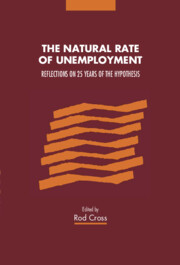Book contents
- Frontmatter
- Contents
- List of Contributors
- Preface
- 1 Introduction
- Part I The theoretical framework
- Part II Adjustment, ranges of equilibria and hysteresis
- 6 The economics of adjustment
- 7 Hysteresis and memory in the labour market
- 8 Models of the range of equilibria
- 9 Hysteresis revisited: a methodological approach
- 10 Is the natural rate hypothesis consistent with hysteresis?
- Part III Empirical tests and macro models
- Part IV Political economy
- Index
9 - Hysteresis revisited: a methodological approach
Published online by Cambridge University Press: 03 May 2011
- Frontmatter
- Contents
- List of Contributors
- Preface
- 1 Introduction
- Part I The theoretical framework
- Part II Adjustment, ranges of equilibria and hysteresis
- 6 The economics of adjustment
- 7 Hysteresis and memory in the labour market
- 8 Models of the range of equilibria
- 9 Hysteresis revisited: a methodological approach
- 10 Is the natural rate hypothesis consistent with hysteresis?
- Part III Empirical tests and macro models
- Part IV Political economy
- Index
Summary
It is somehow logical that economists have been tempted to use the concept of hysteresis in the field of unemployment theory since its apparent properties seem to fit rather well with the employment dynamics of the 1980s. Roughly speaking, if the rise of unemployment can easily be related to the ‘low growth context’ of the 1970s, it is more difficult to account for the persistence of high unemployment during the recovery of the 1980s, especially in Europe. This puzzle suggests that one should go beyond the ‘traditional’ reversible dynamical tools of economic theory. In this perspective, the concept of hysteresis and its properties of ‘remanence’ appear very appealing.
The economic literature confirms this particular interest of unemployment theory for the concept of hysteresis (Blanchard and Summers, 1986, 1988; Sachs, 1987; Layard, Nickell and Jackman, 1991). The frequency of its uses calls for an examination of the concept in itself, abstracted from its actual economic content, and from a more formal point of view. This effort is all the more desirable since the uses of the term entail some difficulties.
Actually the precision and general nature of the definitions of this concept borrowed from physics vary greatly from one author to another, and their status is uncertain. For instance, Blanchard and Summers (1986) explained that they did not intend necessarily to abide by the definition that they gave in a footnote. Still more disturbing is the fact that the definitions do not, for the most part, coincide from one text to another.
- Type
- Chapter
- Information
- The Natural Rate of UnemploymentReflections on 25 Years of the Hypothesis, pp. 153 - 180Publisher: Cambridge University PressPrint publication year: 1995
- 22
- Cited by

